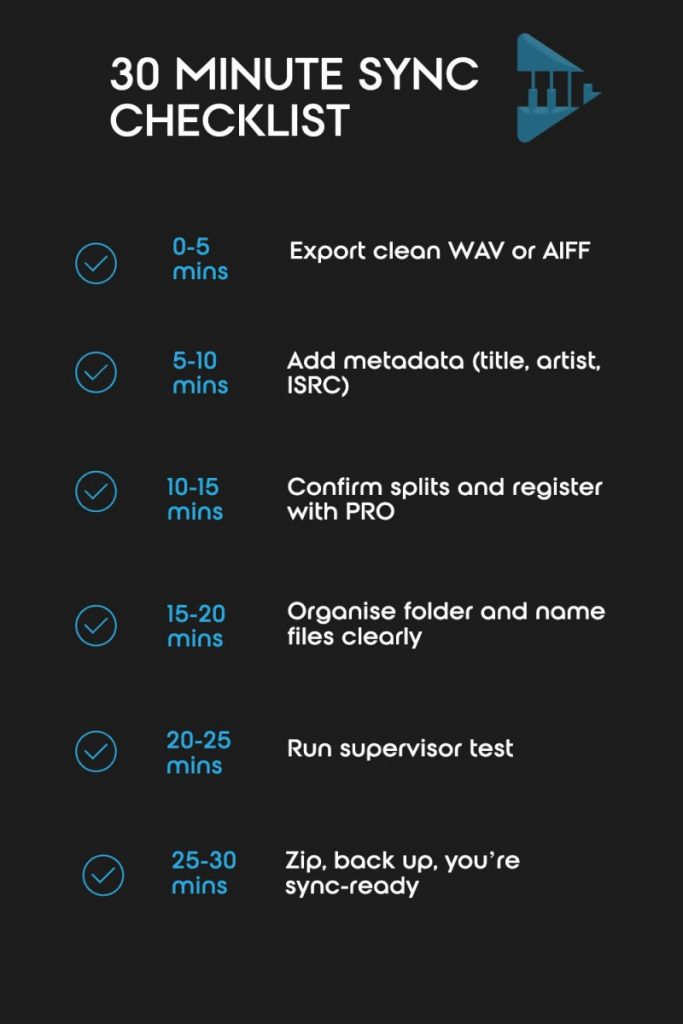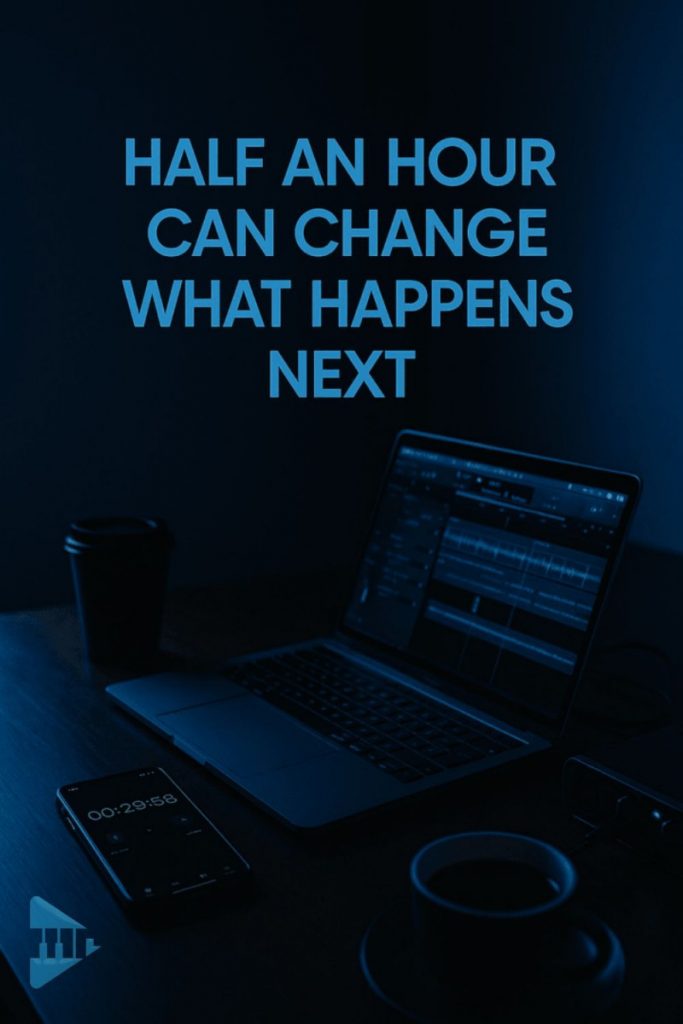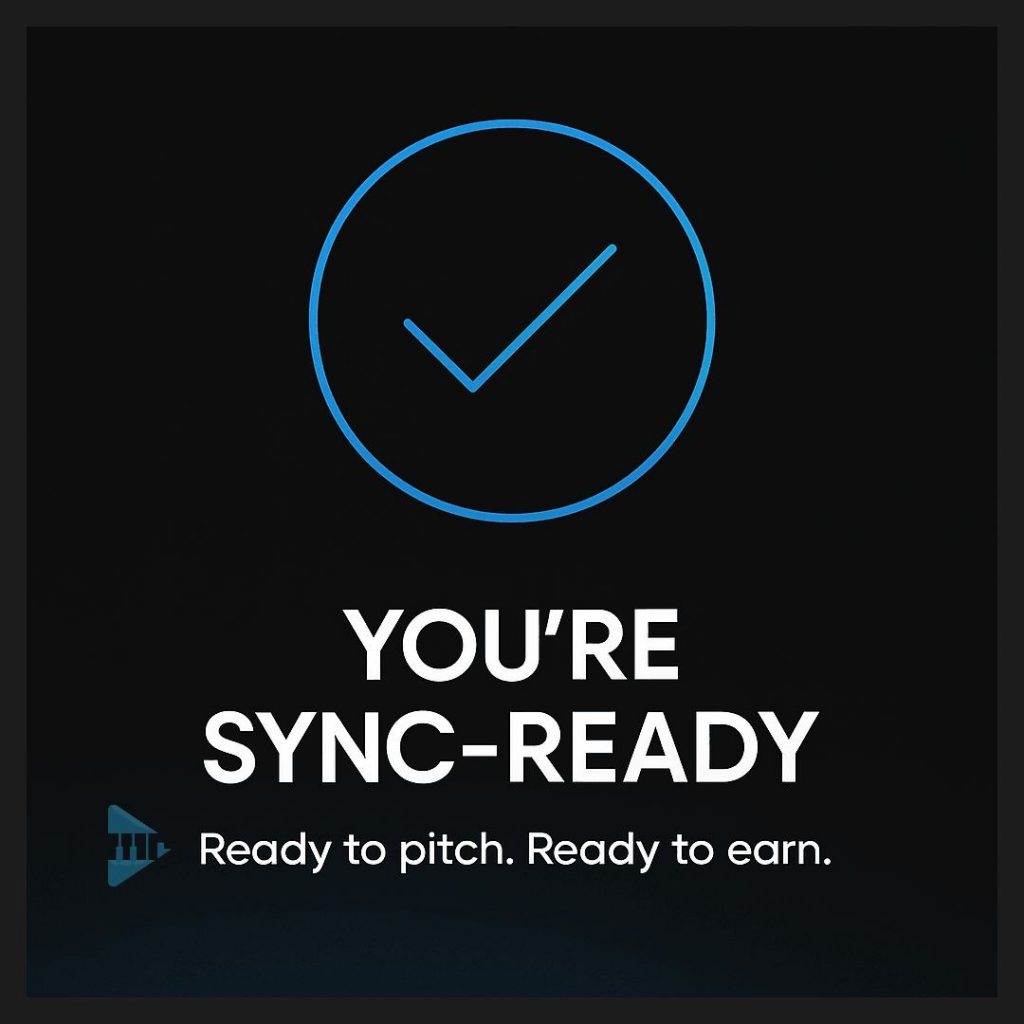Table of Contents
ToggleTL;DR / Quick Answer
To get your music sync-ready for music licensing for film and TV, spend 30 focused minutes preparing one track:
- Export high-quality WAV or AIFF files
- Create instrumental and clean versions
- Add correct metadata (title, artist, ISRC, PRO info)
- Confirm splits and publishing rights
- Organise a clear folder with your one-sheet and contact info
When a supervisor can drag and drop your track straight into a scene, you’re ready for sync placements.
Here’s how to make your track sync-ready step by step.
Get Your Tracks Ready for Music Licensing for Film and TV – Fast.
You’ve probably lost 30 minutes today already.
Scrolling. Checking plays. Watching someone else post about a placement and thinking, I should be doing that.
That same half-hour is all it takes to get one of your finished tracks ready for sync. Really ready.
Not “I’ll fix the metadata later” ready. Not “I’ll find the stems next week.”
Ready as in: someone could drag your file into a film scene right now and hit play.
This isn’t a big job. It feels like one, because the word “admin” makes most musicians shut down.
But it’s just 30 minutes of focused setup. Coffee on the table and aiirPods in. You can do this today.
Why it matters
Music supervisors (the people who choose and license songs for film, TV, and ads) don’t have time to chase missing files or broken links. They open, they listen, they move on.
If your song isn’t organised, it doesn’t get a second look.
And the sync world keeps growing.
Last year, global recorded music revenues grew by 10.2 % (IFPI) – with sync riding the same upward wave of demand.
There is constant demand for new music needed for film, TV, and online ads, but only if it is ready to use.
That’s more projects, more screens, more chances to earn from the same track you already made.
But only if it’s ready.
Expert Insight from Bobby Cole, Founder of Melody Rights
“When you’re creating tracks for sync, keep your intro incredibly short, ideally one bar. Music supervisors are sent hundreds of songs every week, and they don’t have time to wait a full minute to reach the chorus. In most cases, it’s the main hook or chorus that ends up getting licensed for film, TV, or ads.
Always make sure what you’re pitching actually matches the brief, and send it in the format they’ve asked for. Supervisors don’t chase missing files or broken links; they just move on. Keep your tracks clean, simple, and well-produced, and focus on making that main hook shine.” (edit note: pop in quote format)
Pay attention to how supervisors and music libraries want to receive your tracks.
Many won’t open MP3 attachments in emails, so it’s better to send a streaming or download link instead. Platforms like Disco, SoundCloud (set to private), or Dropbox are all standard.
Always follow submission guidelines exactly as they’re written. It shows professionalism, respect for their process, and makes it easier for them to actually listen to your song.
Quick Answer: what “sync-ready” really means
In the next 30 minutes, you can:
- Export your song as lossless WAV or AIFF files
- Save instrumental and clean versions
- Add proper metadata: title, artist, ISRC, contact email
- Confirm your songwriting splits and PRO registration
- Drop everything into one clear folder with a one-sheet
If someone can open that folder and use your music instantly, you’re sync-ready.
The 30-Minute Sync-Ready Checklist
You can do this in half an hour.
Here’s what that actually looks like on screen.

Now, let’s break each stage down so you can follow it in real time.
How to Get Sync Placements (Fast Checklist)
Grab your phone and set a timer for 30 minutes.
Pick one finished track. When the timer goes off, it’s done.
No theory, no planning. Just doing.
Moving fast with no overthinking, it’s about making the track usable right now.
0–5 minutes: export clean, high-quality files
Open your project.
Bounce your final mix as a WAV or AIFF.
Keep it 16- or 24-bit. 44.1 kHz.
No MP3s. They get deleted by supervisors without a second thought.
Export instrumental and clean versions too, you’ll need them later.
✅ Done? You’ve already finished the most technical part.
5-10 minutes: add your metadata
Right-click the file. Hit “Properties” or “Info.”
Fill in the basics: song title, artist name, your contact email.
If you have an ISRC, add that too.
Drop the BPM and key somewhere in the notes field.
It helps editors sync faster.
✅ Finished this part? You’ve just made your song searchable.
10-15 minutes: confirm your rights and splits
If you wrote it with anyone else, open the group chat.
Agree on percentages, even if it’s just 70/30 or 50/50.
Write it down. Save a screenshot.
Register it with your PRO when you’re done here.
It’ll save you months of admin later.
✅ Splits done? You’ve just turned a file into a legitimate asset.
15-20 minutes: get your folder clean
Make one folder for the track.
Inside it:
- Main mix
- Instrumental
- Stems (if you have them)
- One-sheet PDF with your info and splits
Name everything clearly.
Example: ArtistName_SongTitle_Instrumental.wav
If anyone can open that folder and find what they need, you’ve nailed it.
✅ Folder organised. Ten minutes left.
20–25 minutes: run the supervisor test
Pretend you’re a music supervisor with a tight deadline.
Can you drag it straight into an edit? Clear labels? Playable? Email visible?
If not, fix it before you close your laptop.
✅ You’re almost there.
As Bobby Cole explains,
“Supervisors listen for the part they’ll actually use, which is almost always the hook. Keep your intro short, skip the key changes, and get to the chorus fast. If they can’t imagine dropping your track straight into a scene, they’ll move on.”

That’s the truth every artist learns eventually, if your files aren’t usable, no one’s waiting around.
25-30 minutes: lock it in and save
Zip the folder.
Name it the same way you named your files.
Back it up somewhere safe.
That’s it. One sync-ready track.
You just added value to your catalogue in the time it takes to finish a coffee.
“Most artists lose placements not because of their music, but because their files aren’t ready.”
- Bobby Cole, Founder of Melody Rights

If you’ve ever looked up and realised half an hour’s gone by on your phone…
Reclaim Your Time
If you’ve ever looked up and realised half an hour’s gone by on your phone, this part’s for you.
That same window of time can make one of your tracks ready for real opportunities.
This isn’t about rushing. It’s about using a small block of focus to move forward instead of sideways.
Perfection can wait, progress can’t.
Put the phone down, hit play on something that keeps you moving, and finish the setup.
Bobby sums it up perfectly:
“Being sync-ready isn’t about perfection. It’s about being prepared. A finished, usable track will always beat a perfect one that’s still sitting on your hard drive.”
In less time than a scroll session, you’ll have a song that’s genuinely ready for sync.
Where Melody Rights Fits
Once your songs are packaged and ready, you need a place that helps you put them to work.
That’s what Melody Rights does.
We help you submit sync-ready tracks for film, TV, games, and ads while keeping your rights intact.
No exclusivity. No gatekeepers. Just clear paths from your folder to real placements.
Most artists spend hours researching the best sync licensing companies, but Melody Rights keeps it simple by putting your tracks directly in front of them.
If you’re new to sync, start here:
- Submit Music for Film and TV – how to get your tracks in front of supervisors
- What Is a Synchronization License – know the deal you’re signing
- How to Get a Sync License – step-by-step on fees and rights
- Sell Music to Companies in 2025 – where brands are actually looking for tracks
- How to Sell Your Music for Artists – make sure you get paid properly
This post gets you ready. Those guides take you further.
Melody Rights connects your music directly to sync companies and supervisors worldwide.
FAQ
How do I get sync placements?
Start by preparing your music properly. Then submit to placement companies or platforms like Melody Rights that connect indie artists to real sync opportunities.
What format do supervisors expect?
Supervisors expect professional, ready-to-use files. Always send lossless WAV or AIFF versions, include an instrumental, and label everything clearly.
How much does a sync license cost?
It depends on the project, but preparation always increases your odds of landing a placement.
Do I need both publishing and master rights to pitch?
Yes. You need control or written clearance for both sides before anyone can legally use your song.

Pass It On
You just spent half an hour that moved your music forward.
Most artists keep saying they’ll get around to it.
If you know someone like that, send them this post. It might be the push they need to stop scrolling and start earning.



